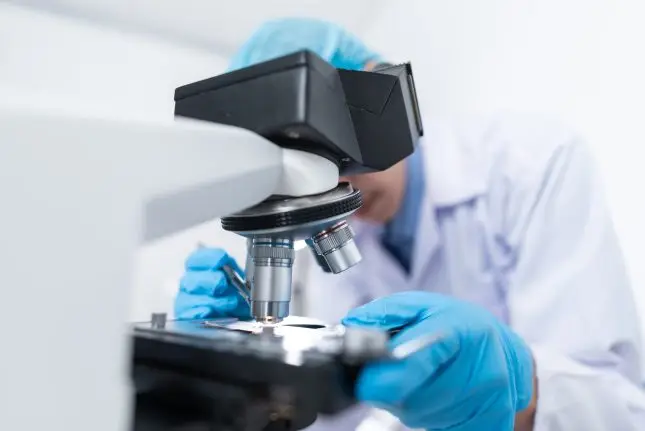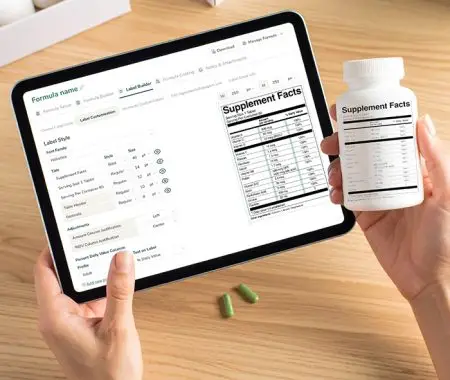In today’s competitive food industry, businesses are confronted with the challenge of accurately detailing the nutritional composition of their products. With an increasingly health-conscious consumer base, companies face the pressure to provide transparent and dependable information about the nutritional values of the items they offer.
While the FDA does not prescribe a specific method for determining specific nutrient content in food labeling, they expect companies to be diligent and accurately report information their food labels. This is where labaratory analysis for nutrition calculations and nutrition analysis software comes in.
Food labaratory analysis and nutrition analysis software are crucial processes and sources used to determine nutrient values of food products. Both methods also have their pros and cons, and it can become challenging when deciding which one is better. Let’s take a deep dive and explore each main method in more detail.
Summary:
| Food Laboratory Analysis | Nutritional Analysis Software | |
| Pros |
|
|
| Cons |
|
|
Food Laboratory Analysis
Food Laboratory Nutrition Analysis is a scientific method used to determine the nutritional content of food products. It is performed in specialized laboratories equipped with advanced tools and techniques that measure the specific nutrients present in a food sample. Here’s a breakdown of what it involves:
- Sample Collection: A representative sample of the food product is taken to the laboratory for analysis.
- Macronutrient Analysis: This step measures the content of proteins, carbohydrates, and fats, which are the main contributors to a food’s energy value.
- Micronutrient Analysis: Laboratories determine the levels of vital vitamins and minerals, ensuring the product meets dietary and health standards.
- Contaminants and Allergens: Testing is performed to detect potential contaminants like heavy metals or pesticides and common allergens, ensuring safety for consumption.
- Reporting: Upon completion of tests, a comprehensive report is provided, detailing the nutritional content, which is essential for creating the Nutrition Facts label on packaged foods.
In essence, food laboratory nutrition analysis offers a precise, scientific approach to determining the nutritional makeup of a food product, ensuring both compliance with regulatory standards and transparency for consumers.
The high level of analytical accuracy involved in labaratory testing takes into account factors such as changes in nutritional value that take place due to cooking and the processing of food. The laboratories can also identify food-related issues and information regarding the composition, nutritional value, the identification of allergens and microbiological contaminants, and the generation of nutritional labels or ingredient listings.
It is also used to find bioactive compounds found in foods, prevent food poisoning, shelf life calculations, and as aforementioned, ensure regulatory compliance.
Pros
- Accuracy:
Food laboratory testing offers a detailed and highly accurate analysis of the nutritional content of food products.
- Quality control:
Ensures the maintenance of consistent food product quality, and can help identify contamination in raw and finished goods.
- Validity:
The data available would be valid due to the high level of accuracy for the nutritional content of food products.
- Product development:
Food laboratory analysis can help identify the nutritional composition of foods, evaluate shelf life, sensory inspections, identify allergens, and discover bioactive compounds. This information can be used to develop new products or improve existing ones.
- Processed food analysis
Food laboratory analysis is very important for heavily processed foods. For instance, in the case of a fried product, it can be challenging to determine the extent to which the ingredients and nutritional components of the product change, and the remaining oil content after frying, without laboratory analysis.
Cons
- Costs
Food laboratory analysis can become very expensive, especially when there are multiple tests needed or if trained professionals and specialized equipment are required. The price will, on average, range from somewhere between $500 to $1000 per recipe.
- Time-consuming
There are many steps involved in a food laboratory analysis such as sample collection, preparation, testing, and data analysis. This process can take up to 30 days or more.
- Lack of real-time results
Food laboratory tests do not always produce immediate results, which can affect timely decision-making if urgent food issues or quality problems arise.
- Accessibility
It can become challenging to access advanced laboratory facilities, especially for manufacturers located in remote areas. Challenges can also arise when conducting comprehensive analysis or complying with certain regulatory requirements.
- Physical Sampling:
Sending a physical sample to private labs for food laboratory analysis presents challenges. There are potential issues like physical contamination of the samples. Additionally, these labs often require a specific amount of samples for examination. This process can be both time-consuming and challenging at the same time.
See How FoodLabelMaker Can Help You
Nutrition Analysis Software
Nutritional analysis software is a computer software that makes use of a database that’s designed to assist in the calculation and analysis of the nutritional content of food products. The software includes a nutrient database that contains the nutrition content of a variety of food products which range from fresh produce to packaged products/foods.
The software is able to let you input data such as ingredients and quantities used for a recipe or food product and calculate the nutritional value based on the given data. Making use of this type of food and nutrient tracking software allows individuals to adopt a precise approach to improving their food habits and allows for food companies to consequently provide them with such information.
With over 5 years of academic and clinical experience, Faheem Mustafa is a registered dietician with a strong academic background in nutrition and dietetics. He specializes in personalized dietary plans, and writing recipes, and has published several articles in renowned journals, winning numerous accolades for his work. Having worked extensively as a dietitian and utilizing this nutritional analysis tool, Faheem can confidently say that nutrition analysis software is a resource, for both individuals and nutrition professionals.
According to Mustafa, from past experience in his practice,
“The software’s vast nutrient database offers a range of options for analysis whether it’s basic ingredients or packaged foods. With this application, I am able to input the components and quantities used in recipes or food products to obtain values efficiently. This level of accuracy is crucial in my profession as it empowers me to create nutrition plans for each of my clients.”
Professionals from industries, including the food business, research institutes, and healthcare settings rely on this software, for menu planning, product development, and research purposes. Due to its flexibility and accuracy, it plays a role in promoting wellbeing and health by facilitating informed decisions regarding diet.
Elaborating further, Mustafa states that,
“It has been very helpful in guiding my clients about healthy habits with its large database, accurate calculations, and user-friendly display. Undoubtedly, this innovative technology will continue playing a key role in the nutrition field by helping both professionals and individuals towards achieving their goals.”.
Nutritional analysis software is widely used in the food industry, as well as in research institutions, healthcare settings, and for professionals who make use of nutrition software and planning.
Pros
- Cost-effectiveness
Nutritional analysis software is less expensive than making use of food laboratory analysis, as it does not require specialized training and expensive equipment.
- Accuracy and precision
This software is usually accurate and provides precise calculations of the nutritional content in recipes and food products. The process eliminates the risk of human error in manual calculations and ensures reliable and accurate data for making the right decisions.
- Convenience
Making use of nutritional analysis software is fast and convenient. The software significantly reduces the time needed to analyze the nutritional composition of food products. The process is also automated, making it fast and efficient to process, especially when working with large data sets.
- Labeling compliance
Nutritional analysis programs ensure that food manufacturers comply with labeling regulations by producing accurate and compliant nutrition facts labels and ingredient statements, as well as any other regulatory compliance features.
- Customization:
The nutritional analysis software provides customization opportunities for businesses to develop their nutrition fact labels and nutritional claims about standard regulations and recommendations of international organizations.
- Flexibility and Scalability:
Food labeling software’s flexibility and scalability allow customers to personalize labels to meet their branding and packaging needs while quickly managing food labeling protocol, regardless of the scale of their operations. These characteristics make food labeling software a useful tool for a wide range of food manufacturers, from small startups to major corporations, fostering accuracy, compliance, and effective label administration.
Cons
- Data limitations
The reliability and accuracy of nutritional analysis software depend on the quality and comprehensiveness of the database used by that particular software. Some databases may contain only comprehensive data for some food types, which leads to inaccurate results.
- Limited variability
The nutritional content of food can vary. Some nutritional analysis software may not cover certain specialty or regional foods, which can limit applicability for users with specific dietary requirements. These factors can lead to inaccurate results.
- Unreliable data processing
If the recipe or ingredient undergoes heavy processing, this can interrupt the database analysis causing alterations in the nutrient contents in unpredictable ways. Examples include fried foods, challenges in measuring the oil absorption, and changes to the fried ingredients. In such instances, a lab analysis would need to be performed.
- Data entry challenges
It can sometimes be very time-consuming to input accurate data for recipes or food products, especially for dishes that are unique or complex. Incorrect data entry can further lead to an inaccurate nutrition analysis.
Which Analysis is Better?
When it comes to deciding which method is better, food laboratory analysis vs nutrition analysis software, various factors need to be considered, such as:
- Resources
- Specific needs
- And the goals of the organization
Each method has its advantages and disadvantages, and the best option will depend on your specific needs and resources.
Food manufacturers that operate on a smaller scale and require highly accurate and precise analysis should consider utilizing food laboratory analysis. Food laboratory analysis is time-consuming and expensive but ensures compliance with regulations and the identification of potential food contaminants.
Food manufacturers working on a large scale that need analysis of a large number of food products in an efficient and cost-effective manner should consider nutritional analysis software as their choice between lab analysis vs nutrition software. Nutrition analysis software is time efficient and cost-effective, so this is ideal for menu planning or routine analysis. However, the accuracy relies on the data input and the quality of the database used.
The best method for analyzing the nutritional content of food products will depend on various factors, so it is critical to consider the pros and cons when deciding what is the best choice for you or your organization.
Why Choose Food Label Maker?
Choosing nutritional analysis software such as Food Label Maker is a great option if you are seeking lab analysis alternatives for food labels. Food Label Maker will save you time and money and lets you create FDA-compliant food labels, customize labels, and manage recipes and menus, just to name a few.
But do I need lab analysis for nutritional labels? There will be cases where you would require lab analysis, especially when nutrient data is unavailable for specific ingredients or if your food undergoes heavy processing, otherwise it would not be necessary.
Food Label Maker is user-friendly and efficient, making it a practical choice for your business if you are seeking accurate, reliable, and compliant food labeling solutions.



